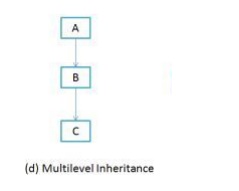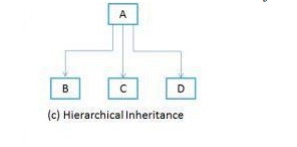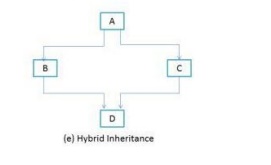Chapter: Object Oriented Programming(OOP) : Overview of Java
Java - Inheritance
INHERITANCE
1. Reusability
is achieved by INHERITANCE
2. Java
classes Can be Reused by extending a class. Extending an existing class is
nothing but reusing properties of the existing classes.
3. The class
whose properties are extended is known as super or base or parent class.
4. The class
which extends the properties of super class is known as sub or derived or child
class
5. A class
can either extends another class or can implement an interface
class B
extends A { ….. }
A super
class
B sub
class
class B
implements A { ….. }
A interface
B sub class
Various
Forms of Inheritance
7.1Defining
a Subclass Syntax :
class
<subclass name> extends <superclass name>
{
variable
declarations; method declarations;
}
•
Extends keyword signifies that properties of the
super class are extended to sub class
•
Sub class will not inherit private members of super
class
Access
Control

Inheritance
Basics
When
super class has a Unparametrized constructor
class A
{
A()
{
System.out.println("This
is constructor of class A");
}
} // End
of class A class B extends A
{
B()
{
super();
System.out.println("This
is constructor of class B");
}
} // End
of class B class inhtest
{
public
static void main(String args[])
{
B b1 =
new B();
}
}
OUTPUT
This is
constructor of class A This is constructor of class B class A
{
A()
{
System.out.println("This
is class A");
}
}
class B
extends A
{
B()
{
System.out.println("This
is class B");
}
}
class
inherit1
{
public
static void main(String args[])
{
B b1 =
new B();
}
}
File Name
is xyz.java /*
E:\Java>java
inherit1 This is class A
This is
class B E:\Java>
*/ class
A
{
private
A()
{
System.out.println("This
is class A");
}
}
class B
extends A
{
B()
{
System.out.println("This
is class B");
}
}
class
inherit2
{
public
static void main(String args[])
{
B b1 =
new B();
}
}
/*
E:\Java>javac
xyz1.java
xyz1.java:12:
A() has private access in A
{
^
1 error
*/ class A
{
private
A()
{
System.out.println("This
is class A");
}
A()
{
System.out.println("This
is class A");
}
}
class B
extends A
{
B()
{
System.out.println("This
is class B");
}
}
class
inherit2
{
public
static void main(String args[])
{
B b1 =
new B();
} }
/*
E:\Java>javac
xyz2.java
xyz2.java:7:
A() is already defined in A A()
^
xyz2.java:16:
A() has private access in A
{
^
2 errors
*/
When
Super class has a parametrized constructor. class A
{
private
int a; A( int a)
{
this.a
=a;
System.out.println("This
is constructor of class A");
}
}
class B
extends A
{
private
int b; private double c; B(int b,double c)
{
this.b=b;
this.c=c;
System.out.println("This
is constructor of class B");
}
}
B b1 =
new B(10,8.6); D:\java\bin>javac inhtest.java inhtest.java:15: cannot find
symbol symbol : constructor A()
location:
class A
{
^
1 errors
class A
{
private
int a; protected String name; A(int a, String n)
{
this.a =
a; this.name = n;
}
void
print()
{
System.out.println("a="+a);
}
}
class B
extends A
{
int b;
double c;
B(int
a,String n,int b,double c)
{
super(a,n);
this.b=b;
this.c =c;
}
void
show()
{
//System.out.println("a="+a);
print();
System.out.println("name="+name);
System.out.println("b="+b);
System.out.println("c="+c);
}
} class A
{
private
int a; A( int a)
{
this.a
=a;
System.out.println("This
is constructor of class A");
}
void
show()
{
System.out.println("a="+a);
}
void
display()
{
System.out.println("hello
This is Display in A");
}
}
class B
extends A
{
private
int b;
private
double c; B(int a,int b,double c)
{
super(a);
this.b=b;
this.c=c;
System.out.println("This
is constructor of class B");
}
void
show()
{
super.show();
System.out.println("b="+b);
System.out.println("c="+c);
display();
}
}
class
inhtest1
{
public
static void main(String args[])
{
B b1 =
new B(10,8,4.5); b1.show();
}
}
/* OutPut
D:\java\bin>java inhtest1
This is
constructor of class A This is constructor of class B a=10
b=8
c=4.5
hello
This is Display in A */
7.2 Types
Single
inheritance
Class A
{
public
void methodA()
{
System.out.println("Base
class method");
}
}
Class B
extends A
{
public
void methodB()
{
System.out.println("Child
class method");
}
public
static void main(String args[])
{
B obj =
new B();
obj.methodA();
//calling super class method
obj.methodB();
//calling local method
}
}
Multiple Inheritance
“Multiple
Inheritance” refers to the concept of one class extending (Or inherits) more
than one base class. The inheritance we learnt earlier had the concept of one
base class or parent.
The
problem with “multiple inheritance” is that the derived class will have to
manage the dependency on two base classes.
Multilevel
Inheritance
Multilevel
inheritance refers to a mechanism in OO technology where one can inherit from a
derived class, thereby making this derived class the base class for the new
class. As you can see in below flow diagram C is subclass or child class of B
and B is a child class of A. For more details and example refer – Multilevel inheritance in Java.

Multilevel
Inheritance example program in Java
Class X
{
public
void methodX()
{
System.out.println("Class
X method");
}
}
Class Y
extends X
{
public
void methodY()
{
System.out.println("class
Y method");
}
}
Class Z
extends Y
{
public
void methodZ()
{
System.out.println("class
Z method");
}
public
static void main(String args[])
{
Z obj =
new Z();
obj.methodX();
//calling grand parent class method
obj.methodY();
//calling parent class method
obj.methodZ();
//calling local method
}
}
Hierarchical Inheritance
In such
kind of inheritance one class is inherited by many sub classes. In below
example class B,C and D inherits the same class A. A is parent class (or base
class) of B,C & D. Read More at – Hierarchical Inheritance in java with
example program.

Hybrid Inheritance
In simple
terms you can say that Hybrid inheritance is a combination of Single and
Multiple inheritance. A typical flow diagram would look like below. A hybrid
inheritance can be achieved in the java in a same way as multiple inheritance
can be!! Using interfaces. yes you heard it right. By using interfaces you can
have multiple as well as hybrid inheritance in Java.
Read the
full article here – hybrid inheritance in java with example program.

Related Topics